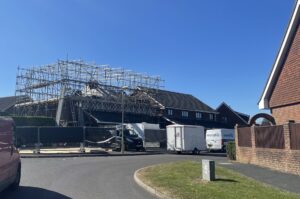Removing asbestos is a challenging task even in normal circumstances, with specialist techniques employed for different types of material, the skill and attention to detail required is very high in order to protect people from the harmful mineral. When asked to carry out asbestos removal from the outside of tower blocks, the challenge becomes even greater, with meticulous planning and a higher than normal level of health and safety considerations to be made.
As part of a major improvement plan across a Southampton social housing estate, Merryhill was invited to carry out the asbestos removal contract involving three separate tower blocks. The Dumbledon, Meredith and Hightown towers on the Thornhill estate were originally constructed in the 1950s/60s and are of an identical design. The regeneration scheme will see each of the blocks receiving a range of energy-saving improvements, including new windows, heating systems managed by tenants, coloured external wall insulation, new roofs and enclosed balconies. ECL Contracts, the facades division of British Gas is managing the project and invited Merryhill to tender for the asbestos removal element of the project.
After thorough surveys had been commissioned prior to the works commencing, asbestos was found to be present in a number of different areas across the Thornhill Towers, including external cladding and balcony panels.
Removing each of the different types of panel was a challenge as everything had to be removed from the outside and at height. All of the towers were 14 storeys high and the only means of access was by mast climbers which had been set up around each building.
Both the cladding and balcony panels were carefully removed and suitably wrapped in 1000-gauge polythene, sealed tight and stacked before being brought down to the crash deck and placed on a pallet. From here, the panels were lifted by telehandler and stored in locked asbestos skips before being transited to landfill. Because of the number of panels being removed, Merryhill had to keep a close monitor of the adjacent properties to ensure tenants did not open any windows for the duration of the works. Although asbestos cement is a relatively low risk material and the removal method is done under wet conditions to minimise any fibre release, the additional protection from keeping windows closed during the works was felt a necessary additional precaution.
Overall, the project was a resounding success with all the asbestos removed from the exterior of each of the towers. Work has now begun on transforming the buildings to improve their energy efficiency, safe in the knowledge that all of the external asbestos has now been removed.





